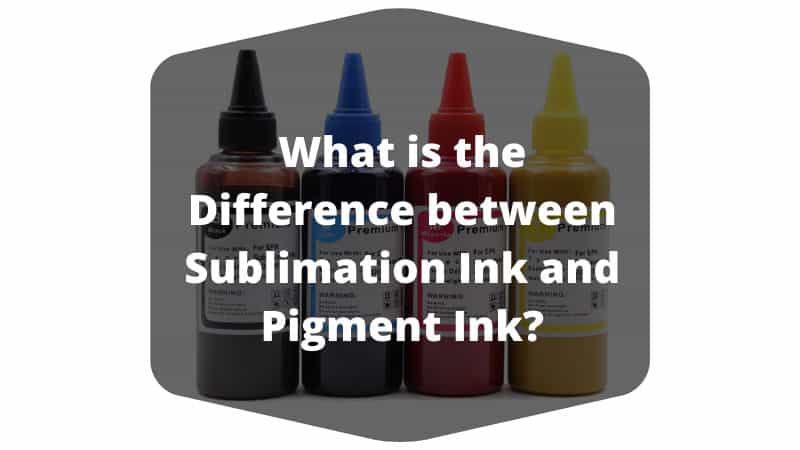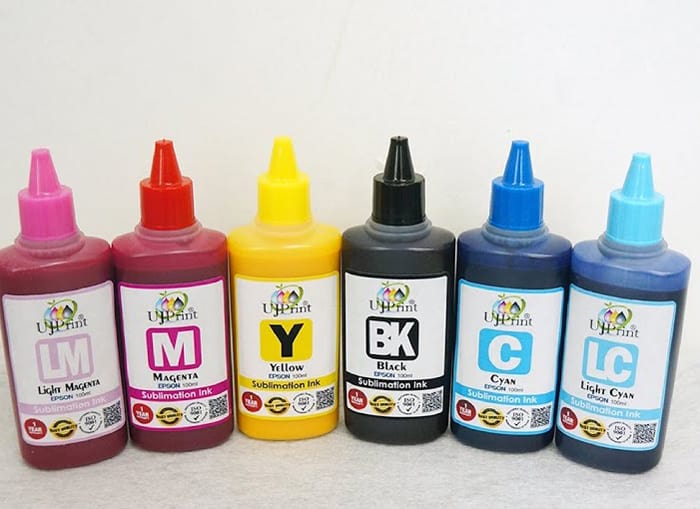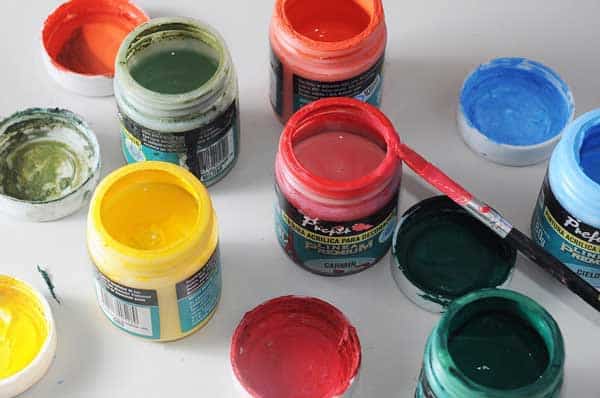What is The Difference Between Sublimation Ink and Pigment Ink?
by Alice Davis
When it’s about printing t-shirts and other textile apparel, people either go with dye sublimation ink or pigment ink. Both the inks have their own way of giving colors to textiles and other objects. There are some areas that one dictates the other one.
As both of them have their own field of excellence, you need to be wise enough to choose one considering what type of printing work you deal with. Using the right type of ink will improve the quality of the products significantly.
On the flip side, choosing a wrong ink can ruin your work and bring a bad reputation for your business. We will discuss about sublimation and pigment ink and see what the differences that give priority one over another are.
Contents

Sublimation Ink

This is the most commonly used ink that you see for sublimating textile products. It transfers ink from paper to fabrics. Sublimation ink is water-soluble that is made from raw and natural materials like plants, or some synthetic materials. The colorant, mixed with the water, gives the ink colors.
Compared to most other dye-based inks, you will find this one lasts longer. The ink is able to produce vivid, bright, saturated, brilliant photo-quality colors. Prints with this ink easily outstand cracking, peeling, and washing away by water.

As the ink contains Cyan Magenta Yellow Overcoating, it eliminates black ink that ensures a clear overcoating ink. Due to this, the printed objects are protected from moisture, air, and UV rays, as well.
Because of its small molecular particle size, the ink gives brilliant and well-saturated colors. The ink is used in most inkjet printers as dye goes well with such printers.
As far as regular document printing is concerned, using the dye ink is recommended for inkjet printing to print PVC cards, paper, photo paper, etc. It’s a more economical option than pigment ink.
Use
Dye sublimation ink is mostly used for heat transfer printing that allows a design to imprint on textiles from paper. The heat press machine delivers heat and pressure, and the dye turns into gas, synthetic fibers of the textile then open to receives the gas. When it’s cool, the colorant encapsulates and sticks to the garment firmly.
Apart from printing textiles, you can also use the ink for printing metal, ceramic, fiberboard, and many other materials. However, a special coating on the surface is required to hold the dye ink properly so that the ink doesn’t get faded and cracked easily.
The ink is designed to print onto polyester rich apparel the most. Sports-wear, carper fabrics, flagging, and sailing materials go perfect with it.
Advantages of Using Sublimation Ink
- Provides bright and more vibrant colors
- A small amount of light is diffused
- Economical option
- Offers a variety of colors
- Waterproof; thus, last for longer
- The designs on garments don’t crack, fade away, peel off, and wash off
Disadvantages of Using Sublimation Ink
- The ink is very sensitive to humidity and oxidation
Pigment Ink
There are minuscule particles of colored material within this ink that provides ink color. These particles are made up of numerous molecules that bond together and create extremely stable chemical bonds. As a result, the ink is less sensitive to humidity and oxidation.
The encapsulated particles remain on top of printed objects, instead completely absorbed into them.
As pigment ink has waterproof properties, it’s ideal to use such ink to print dark and light cotton materials using transfer papers. Most printers with pigment ink provide eight ink colors: black, light gray, medium gray, yellow, magenta, light magenta, cyan, and light cyan. Compared to dye inks, pigments last longer.

One of the major drawbacks of pigment ink is, it doesn’t look the same from different viewing angles; you will notice a bit greenish or bronze color cast from different sides and lighting conditions. Although the ink offers a narrower color gamut, it’s much more stable than sublimation inks in long terms.
Pigment inks are usually susceptible to metamerism, which causes it to shift colors under different lighting conditions.
Due to the large size of pigment particles, they cannot seep into the surface. The inkjet receptor top coat allows the ink to attach to the surface that causes higher media costs.
Use
As pigment inks stay on top of the surface instead completely seeped or absorbed into the surfaces, cotton and natural fabrics fit best with them. Polyester fabrics are not ideal for such an ink to apply on.
For bonding onto the surfaces, you would require an inkjet printer or binder or heat press machine to do that. When it comes to print any documents, nothing beats pigment inks.
Advantages of Using Pigment Inks
- More stable than most dye inks
- More resistant to light, humidity, and oxidation
- Looks stunning on cotton and natural fabrics
Disadvantages of Using Pigment Inks
- Provides less vibrant colors
- Reflects the light due to the larger size of particles
- Changes the appearance if applied on glossy paper or polyester fabrics
- Expensive option
Considering Longevity
Both the inks are durable in different fields. In dark conditions, they both will last up to 100 years without any issue. However, if bright and outdoor lighting condition is what you are considering, sublimation inks take the lead here.
Pigment Vs. Dye Ink: Which One to Choose?
Even a few years ago, pretty much everyone preferred using dye-based inks because of a wide range of colors and being less expensive. But as dye inks are water-soluble, a single drop of water can ruin all your effort. So, even though people were using dye inks, they always expected something better.
Then came the pigmented inks, offering water resistance and longevity. However, pigment inks offer fewer color options and don’t seep deep into the surface.
Recent improvements in ink formulas have pretty much overcome the shortcomings of both the inks. The manufacturers of dye and pigment inks are claiming their inks to be water-resistant. Although they also claim to last a lifetime only on recommended papers, fabrics, and other hard surfaces.
Pigmented inks are for pro users who don’t compromise with the quality. Black and white photographers always go with such inks.
On the flip side, dye-based inks are for enthusiasts who prefer low-cost ink. However, many pro printers still prefer and are satisfied with dye prints.
Sublimation Vs. Pigmented Inks: Which One to Choose for T-shirt Printing?
When it’s about printing your t-shirts, there is no straight-cut answer to the question. You need to go with one depending on the type of garment you are dealing with.
For cotton and natural fabrics, pigmented inks will be good enough to maintain the quality of the products. However, if you print on mostly polyester, blended fabrics, consider using sublimation inks, as they tend to stick to such garments better than the pigmented ones.
Tips for Better Prints
For Documents
- Print with recommended ICC profiles to get consistent image quality for both dye and pigment inks.
- Don’t change the ink during midstream.
- If you use pigment inks in a printer that goes well with dye inks, you will end up clogging the printer. Use recommended inks only.
- Don’t always go with high-resolution prints. Test which print quality suffice your need. Keep the resolution high when it’s about barcodes and data matrix.
- If you leave the ink cartridge open for a long time, it will collect dust and other small particles, which will result in poor print quality. Consider covering the cartridge during downtime.
- Continue using the cartridge until the printer says the inks are running out. Don’t replace it until it’s empty.
- Clean the nozzles every few weeks to allow the printer to free spray out inks and avoid clogging.
For Garments
- Always use a high-quality heat transfer paper to absorb the right amount of ink during the printing process. Low-quality transfer papers tend to absorb inks unnecessarily.
- If the demand is for a less-expensive printing, consider printing on ink-saving mode to ensure efficiency.
- Don’t turn off the printer when you are in between printing two batches of t-shirts. If you turn off and turn the machine on again, it will waste some amount of inks unnecessarily.
- Be sure to take good care of the press machine. Run periodical maintenance to ensure the printer performs optimally. It will save frequent servicing costs and inks. Also, it will ensure a continuous flow of printing.
Final Words
Depending on your working requirements and purpose, you need to decide whether to go with sublimation or pigment ink. If you run a t-shirt business, and you need to print polyester or mixed blended t-shirts, then sublimation ink is the one to choose from.
However, if you deal with cotton fabrics, pigmented ink suits the best for this case. The same goes for printing documents as well.
 |
 |
 |
 |
 |
 |
 |
 |

About Alice Davis
Alice is a writer who lives in the City of Long Beach. She has a husband, an exceptionally small chihuahua, and 15-pound Maine Coon. Alice got her bachelor of science in biological science from UC Berkeley. Now, she likes writing about a lot of things; including but not limited to technology reviews, science stuff, and anything food-related.
Leave a Reply
You can get FREE Gifts. Or latest Free phones here.
Disable Ad block to reveal all the info. Once done, hit a button below
 |
 |
 |
 |